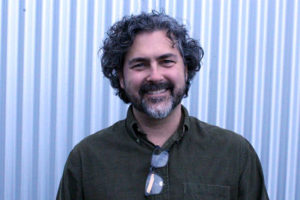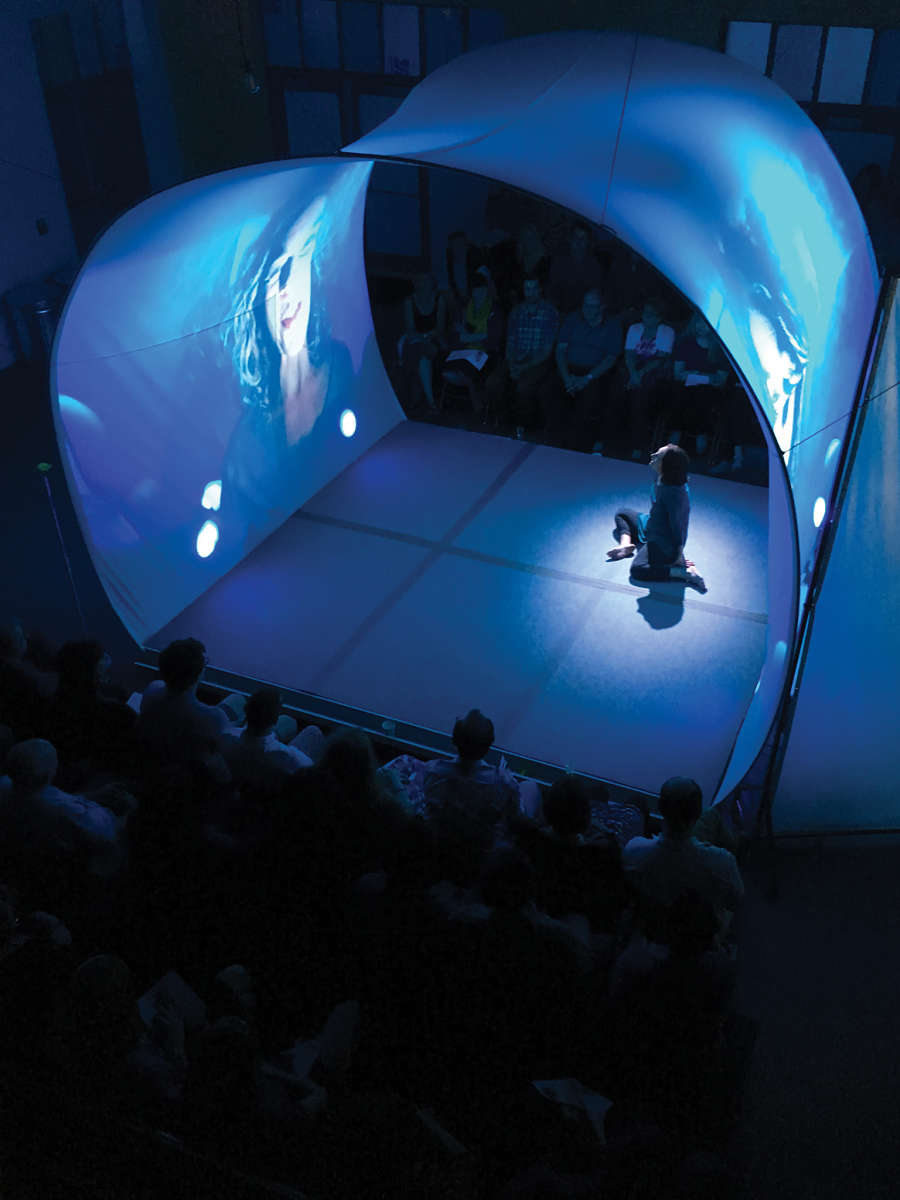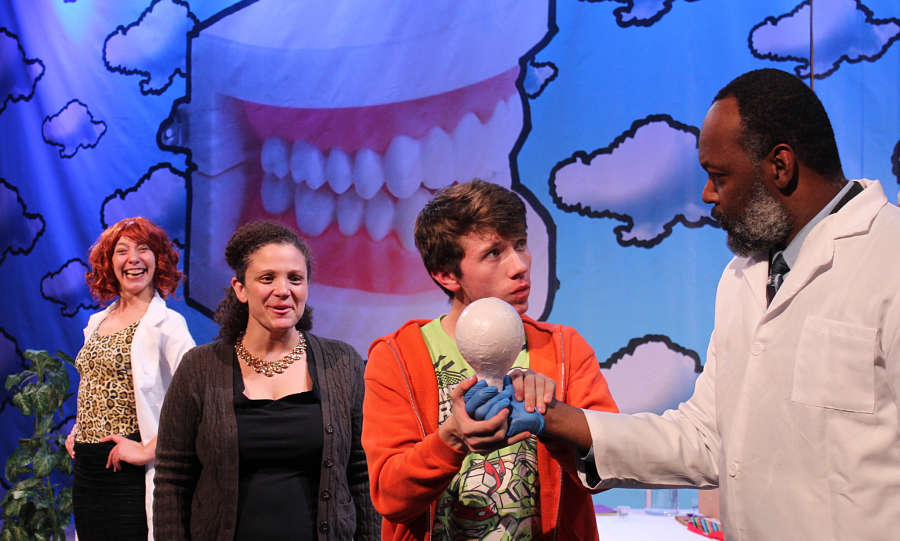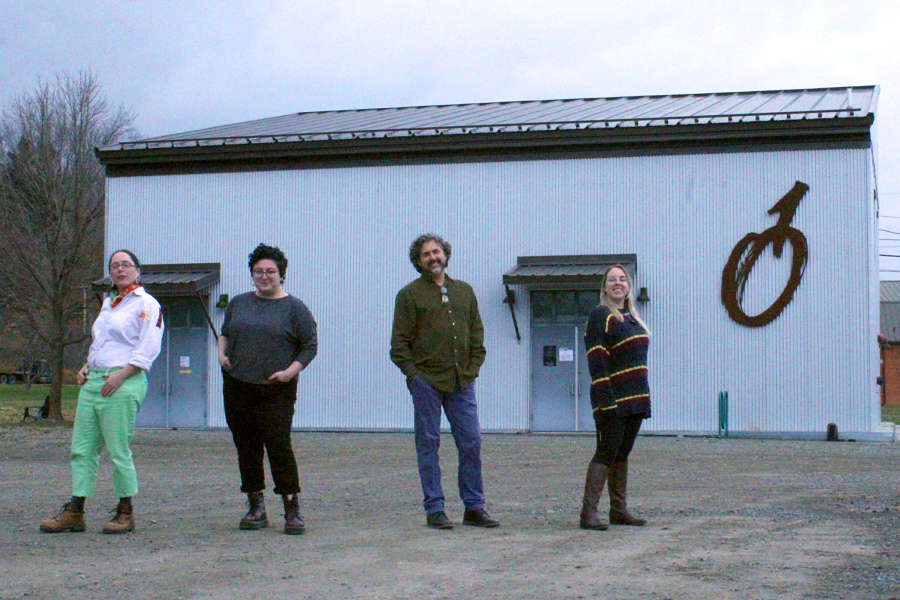ITHACA, N.Y.: Alongside a canal downstream from Cayuga Lake, in a lightly industrial area dotted with auto body shops and a winery, sits a grey and white warehouse with a playfully angled roof and the image of a cherry painted on its south-facing side. Named for the street it’s on, Cherry Artspace is a newish venue for this upstate New York town, which has no shortage of theatrical activity but, in the views of artistic director Samuel Buggeln, had unmet needs both for audiences and artists. And so he co-founded the Cherry Arts, a nonprofit that oversees both an artist’s collective and the venue, at which he programs a wide range of events, theatrical and otherwise, with a strong emphasis on international work. We spoke to Buggeln recently about his company and his ambitions for it.

Who founded the Cherry Arts, when, and why?
SAMUEL BUGGELN: My partner, Nick Salvato, and I founded the company in 2014, and now I’m the artistic director. The vision for the company came from a lot of different impulses converging. First, I was personally experiencing some of the limitations of a full-time freelance directing career based in New York, with a partner based in Ithaca. I was ready to work on building something lasting, and to be in a smaller center where I’d feel like I could meaningfully add to the conversation over time.
Through a stroke of luck, Nick and I found ourselves in the once-in-a-lifetime position to make a space happen in Ithaca (in a way we never could have in New York). Most importantly, though, I was coming to know the artistic community in Ithaca—it’s a small town with two big universities (Cornell and Ithaca College). Basically, faculty members (and their spouses) in the arts—acting, design, playwriting, directing professors—didn’t have a lot of available ways to make work around their teaching and life schedules. So the Cherry Artists’ Collective was born out of this community as a self-governing group of artists, and the Cherry Artspace as a place we could make work.
We decided we wanted to make work that was off the beaten path. I had been getting more exposed to the kinds of plays that get produced in the many other countries with big, evolved theatre scenes. It’s an extraordinary variety, and so we read some international plays in salons and immediately decided that would be a focus. Then we realized that the other great thing theatre can do—that, say, Netflix can’t—is to create work about the community where it happens. So our mission now is to create work that is “radically local, radically global, and formally innovative.” The collective got started about five years ago, and then the Cherry Artspace opened a couple of years ago, in September 2017. We are still a little baby company!
Tell us a little more about yourself.
My relationship to the company is the above. As to myself, I’m a director originally from Canada, and for a variety of reasons I speak good French and pretty good Spanish. For a long time I never really had a way to put those skills to use, but now I run a theatre that does a lot of international work! So I do a fair amount of translating or co-translating alongside my directing. I’m proud that plays the Cherry has produced in translation are starting to get published (in Global Queer Plays from Oberon, and a forthcoming volume, Nothing to Do With Love and Other Plays, from Seagull Books. And… well, fingers crossed.)
On an artistic level I always felt a bit pulled between two poles—I was pulled to more experimental work than a lot of mainstream U.S. theatre was interested in, but I also love a text, I love a play, so I didn’t really find common ground with the devising companies that make up most of the experimental end of our industry. It turns out that weird-but-accessible international plays hit the sweet spot for me.

What sets your theatre apart from others in your region?
Two things, really. As noted, we produce a lot of English-language premieres of plays from other countries—so far France, Germany, El Salvador, Quebec, Serbia, and Argentina a few times. This is not only rare in our region but in the U.S. overall. So we’re super proud of that. These are plays that are in many cases world-famous, with productions in lots of different countries and languages, but not yet in English. Not many people might realize this, but compared to the rest of the world, the English-language theatre ecology is very insular. So we’re thrilled to be getting outside the walls, as it were.
Most of these plays land in the U.S. as kind of experimental or novel in their techniques, partly because that’s where the collective’s taste leads us, but partly because different countries are accustomed to different kinds of theatrical storytelling, so our international plays are always an exciting experiment in, “How is this going to work here?” They break open our brains a bit, as well as our audiences’.
On the other hand, we have our “radically local” projects: We’ve commissioned four pieces from writers who are based here (many with national reputations, like Saviana Stanescu, Wendy Dann, Aoise Stratford, and so on). These projects often engage the histories of this part of the world, creating a literature of our own place, which is a wonderful thing I think a theatre can do. We try to conceive these projects in some formally innovative way, so, for example, two of those commissions were headphone-walking plays. That’s where the audience meets at a predetermined spot, gets given an MP3 player and headphones and some objects, they presses “play” and gets led on an hour-long narrative audio-theatre walk that interweaves the histories of the place with a related fictional narrative. These have become a kind of signature project for us. So on the level of aesthetic mission we’re in a unique lane that compliments the other great theaters in our town, like the Hangar and Kitchen.
The second big way we do things differently is in terms of the space. We named the Cherry Artspace an “artspace” rather than a “theatre” because I wanted to make a flexible room that could accommodate lots of different art forms. So the Artists’ Collective projects are at the core of what we do, and we also host a bunch of other companies in ways that use the space more or less like a theatre—but for just about every performance we configure the room differently. We’ve done runway, thrust, end-stage, in the round, environmental, you name it. That’s become another signature of ours. As I write this a cool local company is producing The Skriker with the audience in a pentagon around the playing space. But we also regularly host a wild and woolly consent-based dance party, video and visual art installations, a variety of experimental uses of what is at the end of the day, a big empty room with a flexible platform and lighting system.
What are the challenges of producing theatre in Ithaca?
I guess they’re not so different from producing in any other small community—I could imagine a world where our population/audience and philanthropic bases were bigger! We have the best fans and supporters in the world—I wish I could photocopy them and make a bunch more! That said, in some ways the smallness of this community has made it possible to make a real mark and build up a lot of enthusiasm quite fast. The other thing is that in upstate N.Y. people are used to driving, and the work we make is unique enough that we think we have room to expand our audience base into other centers within an hour of Ithaca. So we’ve just started really focusing on that marketing and it’s very promising.
Tell us about your favorite theatre institution other than your own, and why you admire it.
Aw, I always have to say New York Theatre Workshop. When I first moved to NYC as a little baby director in the late ’90s, I spent six months seeing like 100 shows—like you do—and then wrote NYTW a letter saying, “I think you are my people.” They invited me to intern there, and then hired me to the artistic staff (in casting) for a time after the internship was over. That company was really formative in my development: keeping things really fresh on an aesthetic level, having an eye on what’s happening in the rest of the world, pushing the formal edges, while always staying on this side of super nutso experimental. (I love super nutso experimental, but it’s not the work I make myself.) I feel like the workshop has stuck to the vision through thick and thin, keeping it both fresh and accessible. I’ll always follow what they’re doing and stop by when I’m in the city.

How do you pick the plays you put on your stage?
For the Collective productions, it’s very much a collective decision. We hold a series of salons where we cold-read newish plays in translation from other places—or, more rarely, works in progress from our own writers—and have sometimes heated discussions about whether we love them and how much. The collective determined early on that we wanted an artistic leader—many of our artists were of an age to have lived through the “all-consensus” collectives of the ’70s and wanted to avoid that stasis! So as the founder and initial ringleader, it’s my job to guide the conversation, read the mood of the room, and make the call. But I’ve never made the call unless the mood of the room was really ecstatic about the play. Productions are a big investment of labor and resources, and there are so many plays out there from so many countries, and the Cherry is only as strong as the empowerment of our circle of artists.
In terms of programming the Artspace, which is not part of the Collective’s job but is part of the Cherry Arts corporate mission— we do a sliding scale or co-producing model depending on the company or artist’s need, and on our goal to keep the space feeling like a place you come to see high-quality work that is pushing the envelope in some way.
What’s your annual budget, and how many artists do you employ each season?
We’re still teeny. Annual budget under $200,000. This season our Collective productions will employ about 20 actors and maybe another 20 artists in other fields. The Artspace as a whole is of course home to scores of artists during a given year—we don’t pay them directly but by making the space affordably available to their work we feel like subsidize them to some extent.
What show are you working on now? Anything else in your season that you’re especially looking forward to?
The Collective is just going into rehearsal for our February show, a gorgeous and poetic play from El Salvador called On the Other Side of the Sea. In its imagistic way it’s about migration and documentation—it’s very funny and moving and at the same time very pertinent to now. We’re in early design and pre-production on a wild and woolly play called Rosa and Blanca by Rebekka Kricheldorf, a German writer we also produced last year. It’s a fabulous retelling of the Grimm fairy tale Snow White and Rose Red, and is about growing up and figuring out how to live a life that is both exciting and sustainable.
Other upcoming Artspace events include The World According to Sound, a 360-degree sound installation project created by PRI podcasters Chris Hoff and Sam Harnett; La Cerise Noire, our vaudeville/burlesque/variety show, and the Crankie Cabaret, an evening of this folk puppetry form called the crankie, curated by LilyPad puppetry, one of our great ongoing collaborators.
Strangest or funniest thing you’ve ever seen (or put) on your stage?
Well, this was before we had a “stage,” but in the time where we had a collective and a property but no building yet, we decided to announce ourselves with an experimental, commissioned, site-specific work on the site where the building would go up. We’re right on a canal, and the piece (which, typically, was based on the histories of this part of our town) began with a character working at a writing desk on the other side of the water. As a narrator on a microphone tells the character’s story, the actress came down to the water, got in a canoe, and rowed over to the side where the audience was. The show interwove four stories, each with a narrator on mic, who would then hand the mic off to the next narrator, and became a character in the next story. (An idea we stole from the Argentine writer/director Mariano Pensotti.) At the end— and by this time the sun has gone down and everyone is lit with big flashlights— a character dies, and gets in the canoe and rows away down the canal and out of sight. (Incidentally, that actor was Godfrey L. Simmons, who was just profiled in American Theatre as he leaves Ithaca to lead HartBeat Ensemble in Hartford. We will miss him! He doesn’t swim so the exit by canoe was a big trust exercise.)
What are you doing when you’re not doing theatre?
I’m not gonna lie, there were a couple of years there when I wasn’t able to do much of anything beyond keeping the operation going! But we’re at a place now where we have a fantastic staff and I’m able to get back to a bit of pleasure reading and stuff like that. I just started a pottery course, so I’m making a variety of pretty but not very useful little vessels. And I do DIY home reno stuff. At the end of the day, making theatre is such a marriage of brain work and physical making—I think the administrative world of writing grants and sending emails is so slanted to the “brain” side that when I get some time off I’m really excited to turn that off and focus on a lump of clay or dripping faucet.
What does theatre—not just your theatre, but the American or world theatre—look like in, say, 20 years?
I won’t pretend to be unbiased when I say that I hope it looks more international than it does in the U.S. now! We’re aiming to start assembling a network of U.S. theatres that produce contemporary international work in translation (beyond Yasmina Reza—nothing against her). We know they’re out there but we’re not at all in touch with one another. Hopefully it will be a way to start building a mini movement. In the way that theaters are excitingly leaning into gender and racial equities, I’d love for us to also really give thought to opening our stages to voices from other languages and parts of the world.


